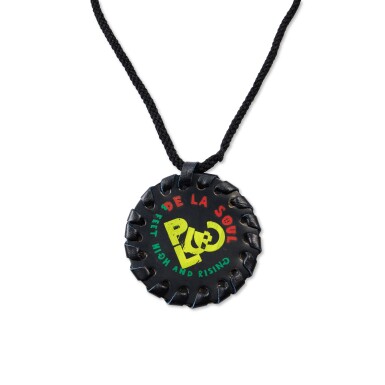Hip Hop
Hip Hop

All proceeds from this sale will go to Hope for Haiti in honor of David “Trugoy the Dove” Jolicouer. Hope for Haiti’s mission is to improve the quality of life for the Haitian people, particularly women and children.
De La Soul
Original "3 Feet High and Rising" Leather Pendant, the first piece of official De La Soul Merchandise from Tommy Boy Records
Lot Closed
July 25, 04:43 PM GMT
Estimate
2,000 - 3,000 USD
Lot Details
Description
Leather pendant (diameter approx. 3 in. ) on 18 in. black nylon cord, painted logo reading “De La Soul 3 Feet High and Rising” in red, yellow, and green. Pendant circumference features leather cording wrapped through punched holes.
From the personal archives of Monica Lynch, former president of Tommy Boy Records (1981-1998)
Chang, Jeff. “3 Feet High and Rising.” Review of 3 Feet High and Rising, by De La Soul. Released March 3, 1989. Pitchfork, September 23, 2018. https://pitchfork.com/reviews/albums/de-la-soul-3-feet-high-and-rising/.
AN ORIGINAL DE LA SOUL LEATHER PENDANT—THE FIRST PIECE OF OFFICIAL MERCHANDISE FOR THEIR 1989 DEBUT, 3 FEET HIGH AND RISING
3 Feet High and Rising (1989) was the debut album of De La Soul (the trio comprised of Kevin "Posdnuos" Mercer, Dave "Trugoy the Dove" Jolicoeur, and Vincent "Pasemaster Mase" Mason, with vital contributions from producer DJ Paul "Prince Paul" Huston). The album was a critical and commercial success, "an unprecedented assemblage of sound... offering a world as richly imagined as anything American pop has ever produced" (Pitchfork). From the personal archives of Monica Lynch, former president of Tommy Boy Records (1981-1998) and the person ultimately responsible for signing De La Soul to the label, the present lot is an original promotional piece commissioned for the release of 3 Feet in ’89.
The pendant features variations of the logo designed by Toby Mott and the Grey Organisation for the 3 Feet album cover, reimagined in red, yellow, and green. The use of both this color scheme and leather as the pendant's primary medium draw on contemporary pan-Africanist aesthetics that were popular throughout the "conscious rap" contingent of Hip Hop artists in the late 80s and early 90s—see Lot #35 for an earlier example of a similar pendant from Afrika Islam and the Zulu Nation.
